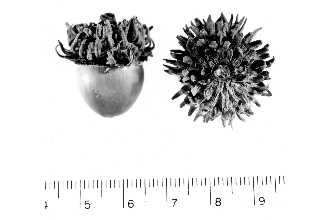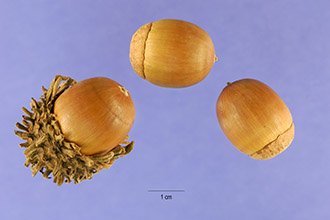Sawtooth Oak
Scientific Name: Quercus acutissima Carruthers

| General Information | |
|---|---|
| Usda Symbol | QUAC80 |
| Group | Dicot |
| Life Cycle | Perennial |
| Growth Habits | Tree |
| Native Locations | QUAC80 |
Plant Guide
Use a soil moisture meter to monitor the soil moisture where Sawtooth Oak is planted.
Fact Sheet
Uses
The primary use for this species is as a wildlife food source and cover. It is also a good shade tree.
Status
Please consult the PLANTS Web site and your State Department of Natural Resources for this plant’s current status (e.g. threatened or endangered species, state noxious status, and wetland indicator values).
Description
Sawtooth oak is a large species, reaching a mature height of 70 feet. The leaves are similar to those of the chestnut but are smaller, 4-8 inches, and have pointed teeth. The acorns are also small in size, ranging from 5/8-3/4 inch long and are enclosed in cups with long, spreading, recurving scales. Approximately 2/3 of the nut is covered by the cup. Trees produce about 150 acorns per pound.
Adaptation and Distribution
Distribution
Distribution
Sawtooth oak is native to eastern Asia but was introduced into the eastern United States around 1920. The range of adaptation extends from Northern Florida west to eastern Texas and Oklahoma, northward through Missouri to New York and into southern New England. On exposed sites in the northern Finger Lakes Region of New York, it may winterkill. Sawtooth oak is winter hardy and can be grown in soils from sandy loam to clay loam. However, the best performance is achieved in deep, well-drained soils. It can also be grown on reclaimed surface mined land where favorable moisture conditions are present and pH is above 5.0. For a current distribution map, please consult the Plant Profile page for this species on the PLANTS Website. C. Miller USDA NRCS
Establishment
One year old seedlings should be planted 15-20 feet apart for maximum acorn production, In areas where multiple rows are used, the spacing should be no less than 20 feet apart, Use soil moisture sensors to measure the soil moisture of Sawtooth Oak., There should be at least 15 plants per planting for effective wind pollination, Site preparation consists of clearing the existing vegetation from an area at least 3 feet in diameter around the newly planted seedling, The seedling should be planted at the same depth it was growing at in the nursery, At the bottom of the hole, apply a handful of 10-10-10 or 18-8-3 fertilizer pellets, Cover the pellets with 2-3 inches of soil, Do not allow the seedling to come in contact with the fertilizer, Water and mulch immediately to conserve water and discourage weeds, If planting by acorns, begin in the early fall, Plant acorns 3/4-1 inch deep, The seedlings should not be transplanted until they reach 12-18 inches in height,
Plant Traits
Growth Requirements
| Temperature, Minimum (°F) | -13 |
|---|---|
| Adapted to Coarse Textured Soils | Yes |
| Adapted to Fine Textured Soils | Yes |
| Adapted to Medium Textured Soils | Yes |
| Anaerobic Tolerance | None |
| CaCO3 Tolerance | Medium |
| Cold Stratification Required | Yes |
| Drought Tolerance | Medium |
| Fertility Requirement | Low |
| Fire Tolerance | Low |
| Frost Free Days, Minimum | 145 |
| Hedge Tolerance | Low |
| Moisture Use | Medium |
| pH, Maximum | 7.0 |
| pH, Minimum | 4.9 |
| Planting Density per Acre, Maxim | 800 |
| Planting Density per Acre, Minim | 300 |
| Precipitation, Maximum | 50 |
| Precipitation, Minimum | 32 |
| Root Depth, Minimum (inches) | 40 |
| Salinity Tolerance | None |
| Shade Tolerance | Intolerant |
Morphology/Physiology
| Bloat | None |
|---|---|
| Toxicity | None |
| Resprout Ability | Yes |
| Shape and Orientation | Rounded |
| Active Growth Period | Spring and Summer |
| C:N Ratio | High |
| Coppice Potential | No |
| Fall Conspicuous | Yes |
| Fire Resistant | No |
| Flower Color | Green |
| Flower Conspicuous | No |
| Foliage Color | Dark Green |
| Foliage Porosity Summer | Dense |
| Foliage Porosity Winter | Porous |
| Foliage Texture | Coarse |
| Fruit/Seed Conspicuous | Yes |
| Nitrogen Fixation | None |
| Low Growing Grass | No |
| Lifespan | Long |
| Leaf Retention | No |
| Known Allelopath | No |
| Height, Mature (feet) | 70.0 |
| Height at 20 Years, Maximum (fee | 60 |
| Growth Rate | Rapid |
| Growth Form | Single Stem |
| Fruit/Seed Color | Brown |
Reproduction
| Vegetative Spread Rate | None |
|---|---|
| Small Grain | No |
| Seedling Vigor | High |
| Seed Spread Rate | Slow |
| Seed per Pound | 150 |
| Fruit/Seed Persistence | No |
| Propagated by Tubers | No |
| Propagated by Sprigs | No |
| Propagated by Sod | No |
| Propagated by Seed | Yes |
| Propagated by Corm | No |
| Propagated by Cuttings | Yes |
| Bloom Period | Mid Spring |
| Commercial Availability | Routinely Available |
| Fruit/Seed Abundance | Medium |
| Fruit/Seed Period Begin | Summer |
| Fruit/Seed Period End | Fall |
| Propagated by Bare Root | Yes |
| Propagated by Bulb | No |
| Propagated by Container | Yes |
Suitability/Use
| Veneer Product | No |
|---|---|
| Pulpwood Product | No |
| Protein Potential | Low |
| Post Product | No |
| Palatable Human | No |
| Palatable Graze Animal | Medium |
| Palatable Browse Animal | Low |
| Nursery Stock Product | Yes |
| Naval Store Product | No |
| Lumber Product | No |
| Fuelwood Product | High |
| Fodder Product | No |
| Christmas Tree Product | No |
| Berry/Nut/Seed Product | Yes |

